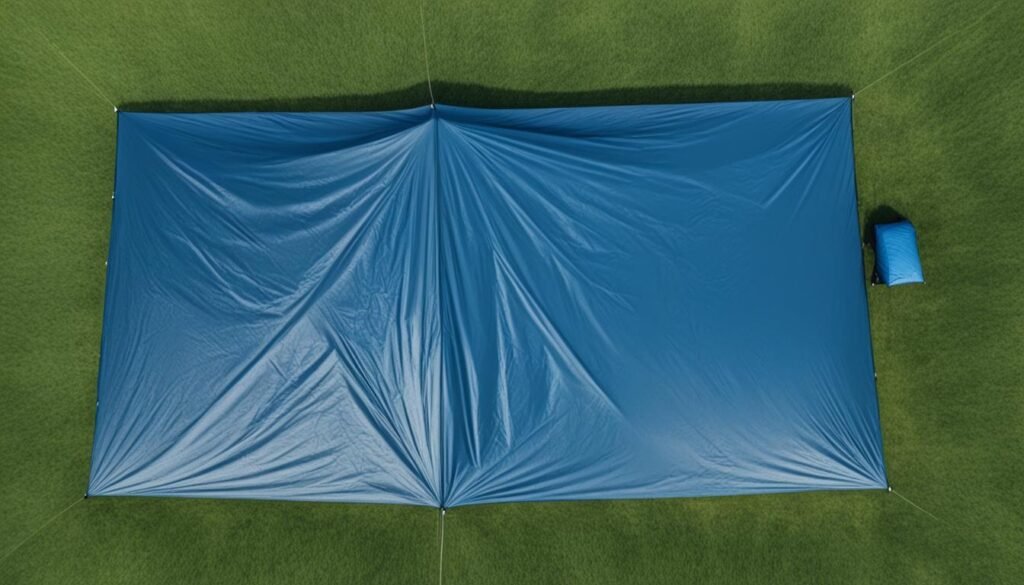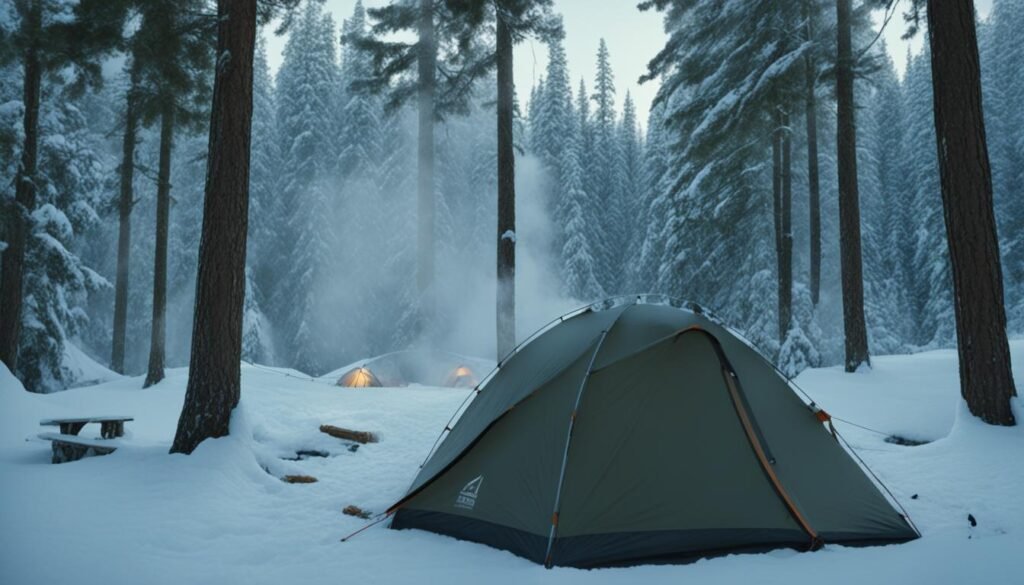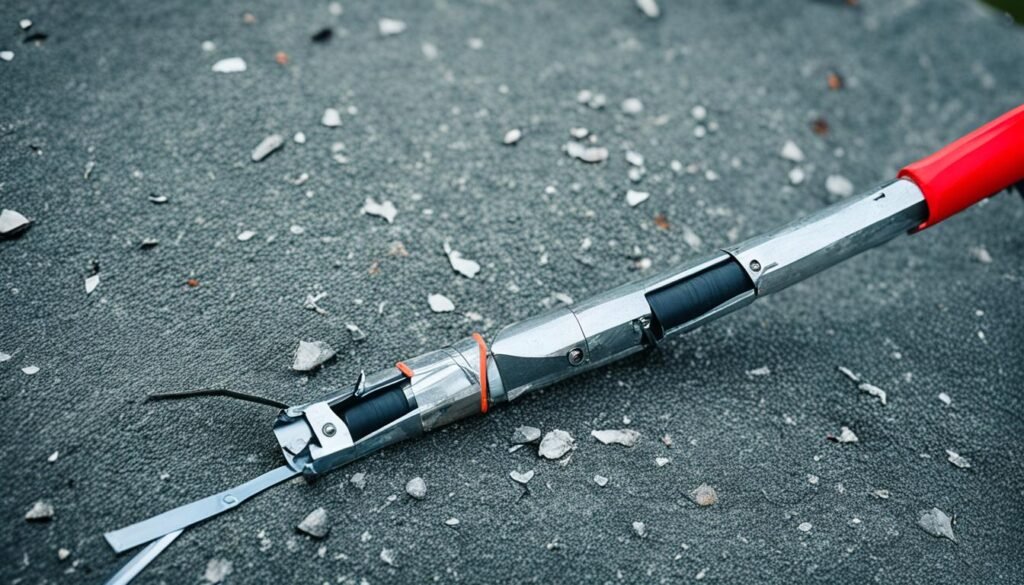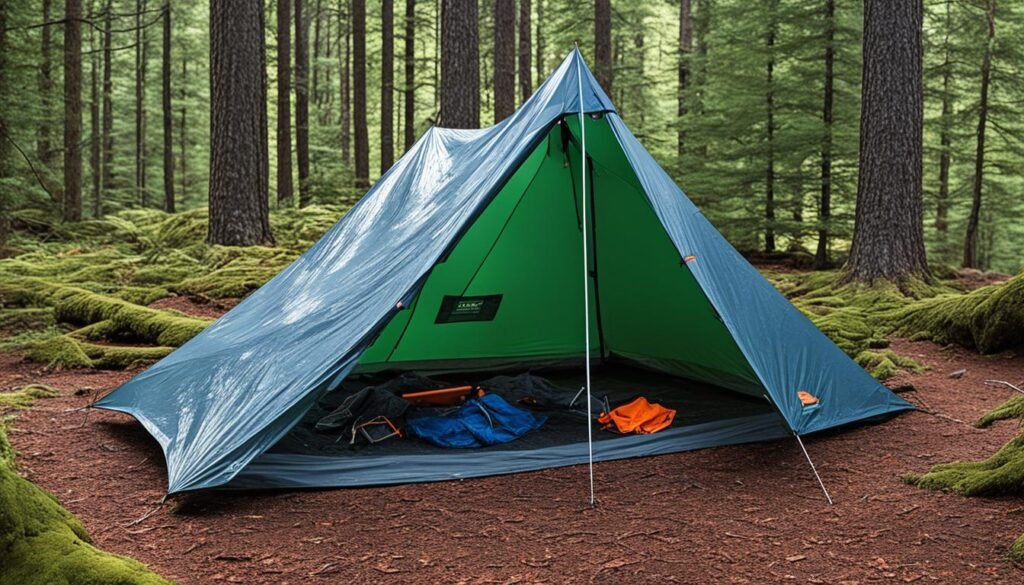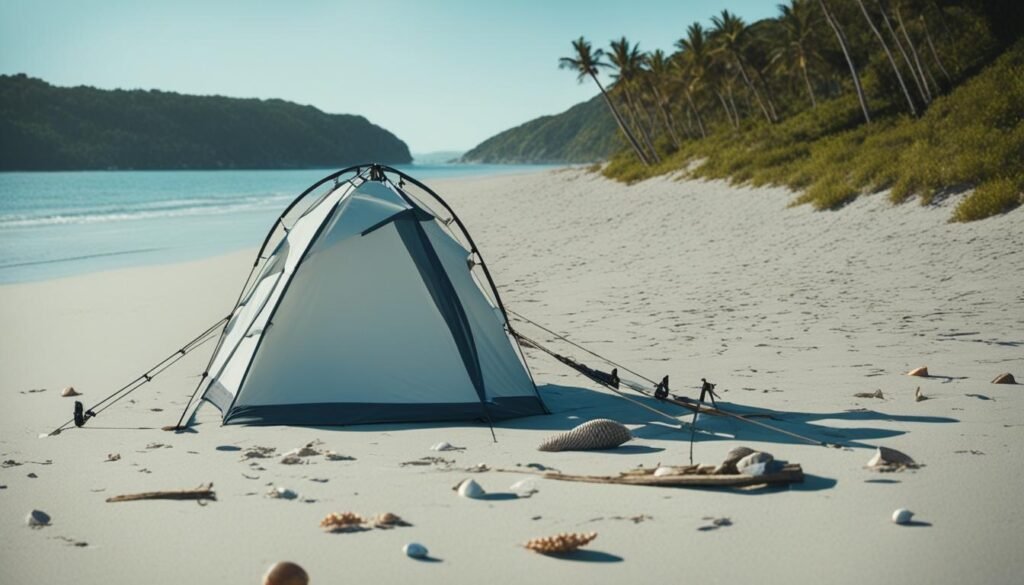When it comes to camping, protecting your tent from moisture and abrasion is essential. One effective way to do this is by placing a tarp under your tent. A tarp serves as a reliable ground cover, regardless of the terrain or location of your campsite. It acts as a barrier, preventing water from seeping into your tent while also shielding the tent floor from any rough or abrasive surfaces.
Properly positioning the tarp is crucial for optimal protection. You can place the tarp under, over, or inside the tent, depending on the specific terrain and weather conditions you’re facing. For instance, if you’re camping on a beach, it’s advisable to use a tarp inside the tent to provide additional protection from the sand.
During inclement weather, a tarp can offer extra shielding. You can use it as an additional layer of protection over the tent or create a shelter around your campsite. By choosing the right type of tarp and properly sealing your tent seams, you can significantly enhance the durability and longevity of your tent.
Key Takeaways:
- Placing a tarp under your tent protects it from moisture and abrasion.
- Using a tarp as a ground cover helps keep the tent floor dry and prevents damage.
- Consider the specific camping environment to determine the best tarp placement.
- Tarps can be used for additional protection during inclement weather.
- Choosing the right tarp and properly sealing tent seams enhances durability.
The Benefits of Using a Tarp Under Your Tent
Using a tarp under your tent offers several benefits. It provides an additional layer of protection against moisture, preventing water from seeping into your tent and keeping your gear dry. A tarp also helps protect the floor of your tent from abrasion caused by rough or abrasive ground surfaces.
“Placing a tarp under your tent is essential for protecting your tent from moisture and abrasion.”
By using a ground cover, you can extend the lifespan of your tent since constant exposure to uneven or abrasive ground can cause wear and tear. Additionally, using a tarp creates a barrier between the tent and the ground, helping regulate the temperature inside the tent. In cold weather, the tarp helps keep the tent warmer, while in hot weather, it keeps the tent cooler.
Overall, using a tarp under your tent enhances its durability, comfort, and longevity. It prolongs the lifespan of your tent by protecting it from moisture and abrasion, ensuring it withstands various camping conditions. Additionally, using a ground cover helps maintain a comfortable and regulated temperature inside the tent, contributing to a more enjoyable camping experience.
When it comes to tent camping, ensuring the protection and durability of your tent is crucial. Using a tarp under your tent provides added protection against moisture and abrasion, keeping your gear and tent floor dry. It also helps regulate the temperature inside the tent for a more comfortable camping experience. Tarps offer countless benefits and are a must-have accessory for any camping enthusiast.
Different Types of Ground Covers and Tarps for Camping
When it comes to camping, having the right ground cover and tarp is essential for ensuring a comfortable and protected outdoor experience. There are various types of ground covers and tarps available that cater to different camping needs and environments. Let’s explore some of the options:
General Camping Tarps
For general camping purposes, it is recommended to use a heavy-duty tarp made of waterproof and durable materials, such as polyethylene or nylon. These tarps come in various sizes and offer both traditional and lightweight options. They provide reliable protection against moisture and abrasion, keeping your tent and gear safe and dry.
Tent Footprints or Groundsheet Tarps
Specifically designed for certain tent models, tent footprints or groundsheets are tailored to fit the dimensions of your tent perfectly. These tarps offer the best-fitting option and provide excellent protection for the tent floor. They are typically made of durable materials that safeguard the tent from wear and tear caused by rough ground surfaces.
Specialized Tarps for Specific Terrains
For camping in unique environments, such as sand dunes or dense woodlands, specialized tarps are available to cater to the specific conditions of these terrains. These tarps are designed to offer optimal protection and performance in these environments. Sand camping tarps are adapted to prevent sand from infiltrating your campsite, while woodland camping tarps provide camouflage and protection from branches and debris.
To choose the best ground cover or tarp for your camping trip, consider the specific needs of your campsite, including the terrain, weather conditions, and the size of your tent. Investing in high-quality tarps that align with your camping environment will ensure that you have the best camping experience with reliable protection and comfort.
| Tarp Type | Features | Recommended Use |
|---|---|---|
| General Camping Tarps | Durable, waterproof, and available in various sizes | Provides reliable protection against moisture and abrasion for general camping purposes |
| Tent Footprints or Groundsheet Tarps | Designed to fit specific tent models perfectly | Offers excellent protection for the tent floor against wear and tear |
| Specialized Tarps for Specific Terrains | Adapted to the unique conditions of sand camping or woodland camping | Provides optimal protection and performance in specific terrains |
How to Properly Place a Tarp Under Your Tent
Placing a tarp under your tent is an important step in ensuring proper protection and longevity of your camping gear. Follow these tarp placement tips and tent set-up instructions to ensure a successful and comfortable camping experience.
Choosing the Right Location
Before placing the tarp, carefully select a location that is on high ground and away from potential hazards. Ensure the area is clear of sharp objects or debris that could puncture or damage the tarp.
Unfolding and Positioning the Tarp
After choosing the location, unfold the tarp and make sure it is slightly smaller than the footprint of your tent. Carefully position the tarp under the tent, making sure it does not extend beyond the edges of the tent. If the tarp is larger than the tent, fold it under to prevent water from collecting under the floor.
Securing the Tarp
Once the tarp is in place, pitch your tent on top of it, ensuring all corners and edges are securely anchored. This will provide maximum protection from moisture and abrasion. Adjust and tighten the tarp as needed to ensure a snug fit.
Remember: The proper placement of a tarp under your tent is crucial for protecting your gear and creating a comfortable camping environment. By following these tarp placement tips and tent set-up instructions, you’ll be well-prepared for your next outdoor adventure.
| Step | Description |
|---|---|
| 1 | Choose a location on high ground and away from potential hazards. |
| 2 | Ensure the area is clear of sharp objects or debris that could damage the tarp. |
| 3 | Unfold the tarp, making sure it is slightly smaller than the footprint of your tent. |
| 4 | Carefully position the tarp under the tent, avoiding any overhang. |
| 5 | If the tarp is too large, fold it under the tent to prevent water accumulation. |
| 6 | Pitch your tent on top of the tarp, ensuring all corners and edges are securely anchored. |
| 7 | Adjust and tighten the tarp as needed to ensure a snug fit. |
Considerations for Different Camping Terrains
When it comes to tarp placement for different camping terrains, it’s important to adapt to the specific conditions of your campsite. Whether you’re camping on sandy beaches or in woodlands, the placement of your tarp under your tent can make a significant difference in protecting your campsite and ensuring a comfortable camping experience.
Camping in Woodlands or Fields
For camping in woodlands or fields, it is recommended to place the tarp under the tent. This not only provides an additional layer of protection but also helps to prevent water from running down the tent walls. To ensure maximum effectiveness, make sure to fold the tarp under the tent, creating a barrier against moisture and potential hazards in the ground.
Camping on Sand
Camping on sand is a unique terrain that requires a slightly different approach. In sandy areas, placing a tarp under the tent is generally not necessary as sand absorbs water quickly. However, to provide additional protection from the sand, it is recommended to place the tarp inside the tent. This helps to prevent the sand from getting into your tent, keeping your sleeping area clean and comfortable.
Remember to assess the specific conditions of your camping environment and adjust the tarp placement accordingly. By adapting to the different terrains, you can ensure optimal protection and enhance your overall camping experience.
| Terrain | Tarp Placement |
|---|---|
| Woodlands or Fields | Place the tarp under the tent, folded under to prevent water from running down the tent walls. |
| Beach / Sand | Not necessary to place the tarp under the tent as sand absorbs water quickly. Instead, place the tarp inside the tent to protect against sand. |
Additional Uses for Tarps in Camping
Tarps are incredibly versatile and can serve multiple purposes in camping. In addition to being used as a ground cover under your tent, tarps can be used to create shelters, cook areas, and seating areas. They provide protection from rain, sun, and wind, allowing you to enjoy the outdoors comfortably.
With their flexible nature, tarps can be set up in various configurations, such as lean-tos, A-frames, or overhead shelters, depending on your needs and the available resources in your camping area. This versatility allows you to adapt to different terrains and weather conditions, providing a reliable and adaptable shelter solution.
When the weather turns unfavorable, tarps can also be used as windbreaks to create a designated space for cooking, eating, and socializing, even in inclement weather. They provide a barrier against strong winds, and by strategically placing them, you can shield yourself and your campsite from the elements.
Moreover, tarps can be used as an additional layer of insulation for your tent. By positioning them on the outside of the tent, they can help to regulate temperature inside the tent. In colder weather, they act as a barrier against the cold wind, while in hotter weather, they can provide shade and reduce the temperature inside the tent.
Overall, by utilizing tarps creatively, you can enhance your camping experience and make the most of your outdoor adventures. Whether you need extra shelter, protection from the elements, or additional insulation, tarps are an essential tool for versatile camping.
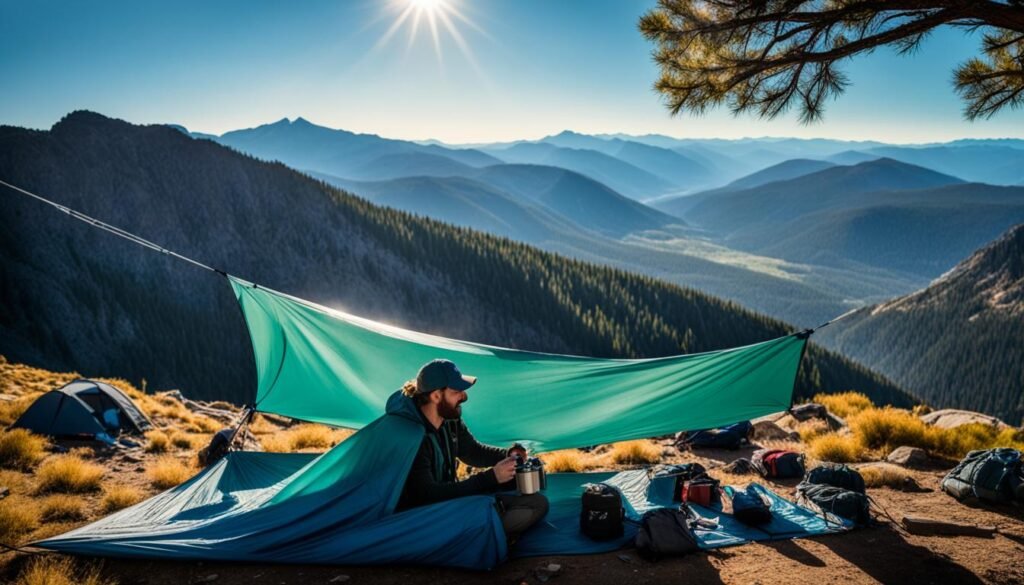
Different Uses for Tarps in Camping
| Use | Description |
|---|---|
| Creating Shelters | Set up tarps in various configurations to create lean-tos, A-frames, or overhead shelters for protection from rain and wind. |
| Cook Areas | Utilize tarps to create designated spaces for cooking and food preparation. |
| Seating Areas | Use tarps to create comfortable seating areas where you can relax and socialize. |
| Windbreaks | Position tarps strategically to act as barriers against strong winds, providing a sheltered campsite. |
| Temperature Regulation | Place tarps outside your tent to provide an additional layer of insulation, keeping the inside of the tent warmer in colder weather and cooler in hotter weather. |
Tips for Building a Tarp Shelter
Building a tarp shelter is an essential skill for any camping enthusiast. By following a few key steps, you can create a sturdy and functional shelter that provides protection from the elements. Here are some tips to help you build a tarp shelter:
- Select a suitable location: Choose a spot with the right distance between trees or other supports. Ensure that the ground is level and free of any obstacles.
- Secure the ropes: Start by securing one end of a rope high up over a limb or support. Wrap the rope tightly around the tree two to three times and anchor it by tying it to itself, a lower branch, or another tree. Repeat this process with the other end of the rope on another support.
- Position the tarp: Place the tarp over the ropes, ensuring that it is centered. Secure the tarp to the ropes at both ends through the center eyelid using twine or wire ties.
- Wrap the tarp around the trees: Lift the tarp tight and wrap it around the trees, tying it securely. Adjust the tension of the tarp as needed to create a taut and resilient shelter.
Building a tarp shelter requires careful attention to detail and proper positioning of the tarp. By following these tips, you can create a reliable shelter that protects you from rain, wind, and other outdoor elements.
Remember to choose a suitable tarp for your shelter, one that is durable and waterproof. Additionally, consider using stakes or rocks to secure the corners of the tarp to the ground for added stability. With a well-built tarp shelter, you can enjoy your camping trip while staying protected and comfortable.
Best Practices for Tarp Shelter Setup
When setting up a tarp shelter, there are several best practices to consider that will help ensure optimal performance and durability.
First and foremost, position the tarp in a way that allows rainwater to run off easily. This will prevent the pooling of water and potential leaks. Keep the tarp tight and free of bulges to avoid water accumulation. Ensure that all corners and edges are securely anchored, using stakes or tie-downs if necessary.
Adjust the height and tension of the tarp as needed to accommodate wind conditions. This will prevent the tarp from sagging or flapping excessively in the wind. Using bungee cords or other shock-absorbing devices can help minimize stress on the tarp during wind gusts, reducing the risk of tearing.
Consider placing windbreaks around the shelter to provide added protection from strong winds. This can be done by using additional tarps, trees, or other natural barriers. Windbreaks will help enhance the stability of the tarp shelter and prevent gusts from causing damage.
| Tarp Shelter Setup Tips | Rain Runoff Prevention | Wind Resistance |
|---|---|---|
| Position the tarp for easy rainwater runoff | Keep the tarp tight and free of bulges | Adjust tension to accommodate wind conditions |
| Ensure all corners and edges are securely anchored | Use bungee cords or shock-absorbing devices | Consider placing windbreaks around the shelter |
By following these best practices, you can maximize the effectiveness and durability of your tarp shelter, ensuring that it provides reliable protection from rainwater runoff and wind resistance.
Using Tarps as Groundsheets
When it comes to protecting the underside of your tent, using tarps as groundsheets can be a practical solution. Whether camping on wet or muddy ground, a tarp can provide an extra layer of defense against moisture and debris. To ensure effective coverage, choose a tarp that is slightly larger than the footprint of your tent. This will allow you to securely tuck the edges of the tarp under the tent, preventing water from seeping in and keeping the bottom of your tent dry.
Using a tarp as a groundsheet not only protects the tent from moisture but also makes the packing-up process easier. When it’s time to leave, you can simply remove the tarp and fold it away, without worrying about wet or dirty tent bottoms. Some campers may prefer to invest in tent footprints or specialized groundsheets designed for their specific tent models. These alternative options offer a tailored fit and provide added protection for the tent floor. However, using a regular tarp as a groundsheet can be a cost-effective alternative that offers similar benefits.
Comparison of Groundsheet Options
| Groundsheet Option | Advantages | Disadvantages |
|---|---|---|
| Regular Tarp |
|
|
| Tent Footprint or Specialized Groundsheet |
|
|
When deciding on the best groundsheet option for your camping needs, consider the advantages and disadvantages of each. Regular tarps offer affordability and versatility, while tent footprints or specialized groundsheets provide a precise fit and enhanced protection. Choose the option that aligns with your budget and specific camping requirements, ensuring that your tent’s underside remains well-protected throughout your outdoor adventures.
How to Keep Dry When Pitching or Packing up in the Rain
Camping in the rain requires some additional precautions to ensure you stay dry and protect your gear. Here are some tips to help you stay dry when setting up or packing up your campsite in the rain:
- Create temporary shelters with tarps: Use tarps to create temporary shelters that provide protection from direct exposure to the rain. These shelters can help you set up your tent and organize your gear without getting wet.
- Wait for the rain to ease: If it’s raining heavily, it’s best to wait until the rain eases before setting up your campsite. This will make the process more comfortable and minimize the risk of getting wet.
- Set up a larger tarp overhead: If the rain is persistent, consider setting up a larger tarp overhead to create a dry workspace. This will provide additional coverage and keep you and your gear dry during camp setup.
- Cover your gear with tarps: When it’s time to pack up camp in the rain, use tarps to cover your gear and protect it from getting soaked. Ensure that your tent and gear are dry before packing them away to prevent mold and mildew growth.
By utilizing tarps strategically, you can stay dry and protect your gear during camp setup and tear-down in rainy conditions.

Emergency Protection for Your Tent
In extreme weather conditions, such as heavy rain or strong winds, it is crucial to have emergency measures in place to protect your tent. When faced with unpredictable elements, using a tarp can provide essential protection to prevent leaks and ensure your camping experience remains comfortable.
If rain is coming from an unusual angle or if there is a risk of water seeping into the tent, strategically placing a tarp over weak points like doors or vents can help prevent leaks. Ensure that the tarp is securely fastened and covers the vulnerable areas of the tent. By using a tarp as a protective shield, you can keep your tent dry even in the most challenging weather conditions.
Additionally, setting up tarps as windbreaks around your tent can provide added stability and protect your tent from wind-driven rain. These windbreaks act as a barrier, shielding your tent from strong gusts and preventing water from penetrating the fabric. By strategically positioning tarps as windbreaks, you can safeguard your tent and minimize potential damage due to extreme weather.
Being prepared and utilizing tarps as emergency measures is essential for protecting your tent during extreme weather conditions. By effectively using tarps to prevent leaks and shield your tent from the elements, you can ensure a safe and comfortable camping experience.
Conclusion
Placing a tarp under your tent is crucial for maximizing the durability, comfort, and protection of your camping experience. By using a ground cover or tarp, you can prevent moisture from seeping into your tent, shielding it from abrasion and maintaining a regulated temperature inside. Tarps are incredibly versatile tools that can serve multiple purposes in camping, including creating shelters, cook areas, and seating areas. When setting up a tarp shelter, it is important to follow proper techniques and consider the specific conditions of your campsite, such as the terrain and weather. Additionally, using tarps as groundsheets or for emergency protection adds an extra layer of reliability to your camping setup. Incorporating tarps into your camping gear will ensure a more enjoyable and comfortable outdoor experience.
Remember, choose the right tarp material for your needs, such as waterproof and durable options like polyethylene or nylon. Ensure that the tarp is slightly smaller than the footprint of your tent and properly position it under your tent or fold it inside to prevent water collection. By following these simple practices, you can extend the lifespan of your tent, protect your gear, and enhance your overall camping experience.
In summary, the importance of placing a tarp under your tent cannot be overstated. It provides crucial protection against moisture, keeps the tent floor safe from abrasion, and helps regulate the temperature inside. Tarps are versatile and can be used for various purposes in camping. Whether you’re creating a shelter, protecting your gear, or setting up a comfortable seating area, tarps are essential tools. Don’t forget to consider the specific conditions of your campsite and follow proper techniques for tarp placement. By incorporating tarps into your camping gear, you can ensure a more enjoyable, comfortable, and reliable outdoor experience.
How Can I Ensure the Tarp Provides Added Protection for My Tent Without Trees?
When setting up tarp without trees, consider using adjustable poles or stakes to create a makeshift shelter over your tent. Secure the tarp tightly to prevent water from pooling and ensure it extends beyond the edges of the tent for extra protection.
FAQ
Why is it important to place a tarp under your tent?
Placing a tarp under your tent is essential for protecting your tent from moisture and abrasion. It helps prevent water from seeping into your tent and keeps your gear dry. Additionally, it protects the floor of your tent from rough or abrasive ground surfaces, extending its lifespan.
What are the benefits of using a tarp under your tent?
Using a tarp under your tent provides several benefits. It adds an extra layer of protection against moisture, keeps your gear dry, and prevents wear and tear on the tent floor. It also helps regulate the temperature inside the tent, making it more comfortable in varying weather conditions.
What types of ground covers and tarps are suitable for camping?
For general camping purposes, heavy-duty tarps made of waterproof and durable materials such as polyethylene or nylon are recommended. There are also specialized tarps for specific terrains or tent models that offer the best fit and protection.
How should I properly place a tarp under my tent?
To place a tarp under your tent, first, choose a level location on high ground. Unfold the tarp and position it slightly smaller than the footprint of your tent. Carefully place the tarp under the tent, folding it under if necessary to prevent water from collecting. Finally, pitch your tent on top of the tarp and secure all corners and edges.
How should I position a tarp under my tent in different terrains?
In woodlands or fields, place the tarp under the tent, ensuring it is folded under to prevent water from running down the tent walls. In sandy areas, place the tarp inside the tent to provide additional protection from the sand. Assess the specific conditions of your camping environment to determine the best tarp placement.
What other uses can tarps have in camping?
Tarps are incredibly versatile and can be used to create shelters, cook areas, seating areas, and more. They provide protection from rain, sun, and wind, allowing you to enjoy the outdoors comfortably. Tarps can also be set up as windbreaks or additional insulation for your tent.
How can I build a tarp shelter?
To build a tarp shelter, select a suitable location and secure ropes between supports. Position the tarp over the ropes and secure it tightly. Wrap the tarp around the trees or supports, tying it securely to create a taut and resilient shelter.
What are some best practices for setting up a tarp shelter?
When setting up a tarp shelter, ensure rainwater runs off easily by keeping the tarp tight and free of bulges. Adjust the height and tension of the tarp to accommodate wind conditions and prevent sagging. Using shock-absorbing devices can help minimize stress during wind gusts. Consider placing windbreaks around the shelter for added protection.
Can tarps be used as groundsheets for tents?
Yes, tarps can be used as groundsheets to protect the underside of your tent. Placing a tarp under your tent when the ground is wet and muddy provides an extra layer of protection. Make sure the tarp is slightly larger than the footprint of your tent and securely tuck it under to prevent water from seeping in.
How can I stay dry when setting up or packing up my campsite in the rain?
Use tarps to create temporary shelters that protect you from direct exposure to the rain when setting up or organizing your gear. If it’s raining heavily, wait until the rain eases or set up a larger tarp overhead for a dry workspace. Cover your gear with tarps during packing to prevent it from getting soaked.
How can I use tarps for emergency protection for my tent?
In extreme weather conditions, such as heavy rain or strong winds, strategically placing a tarp over weak points of the tent can help prevent leaks. Using tarps as windbreaks around the tent adds stability and protects from wind-driven rain.
Why is it important to place a tarp under your tent?
Placing a tarp under your tent is essential for protecting your tent from moisture and abrasion. It helps prevent water from seeping into your tent and keeps your gear dry. Additionally, it protects the floor of your tent from rough or abrasive ground surfaces, extending its lifespan.

